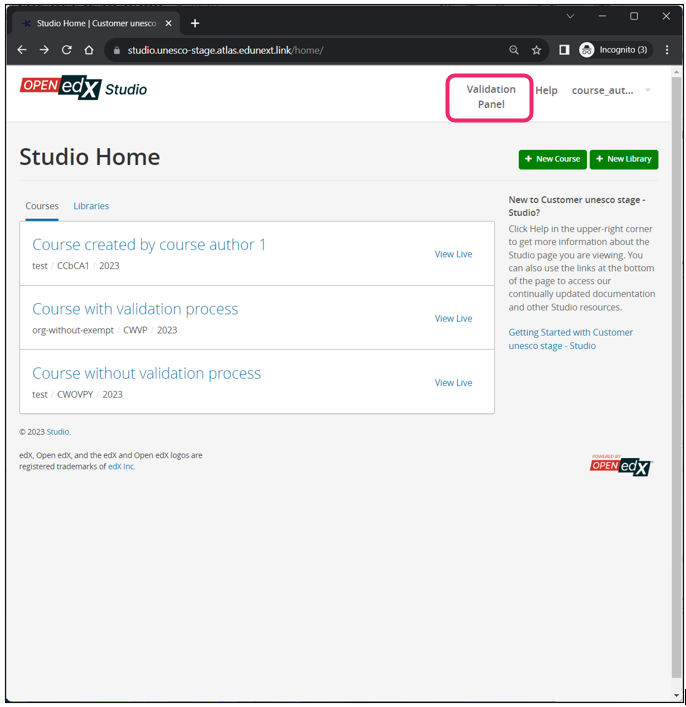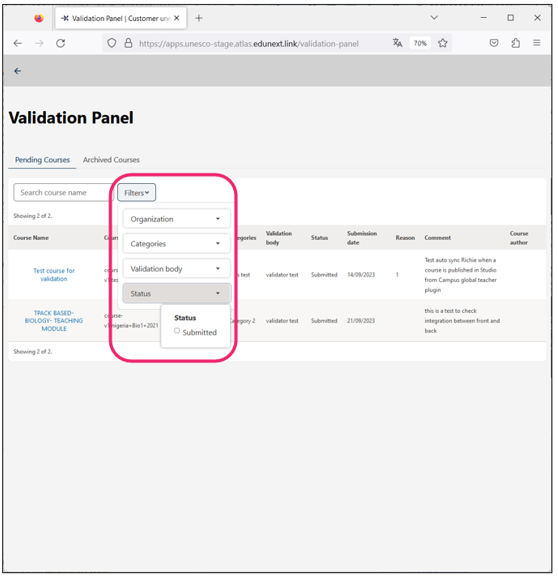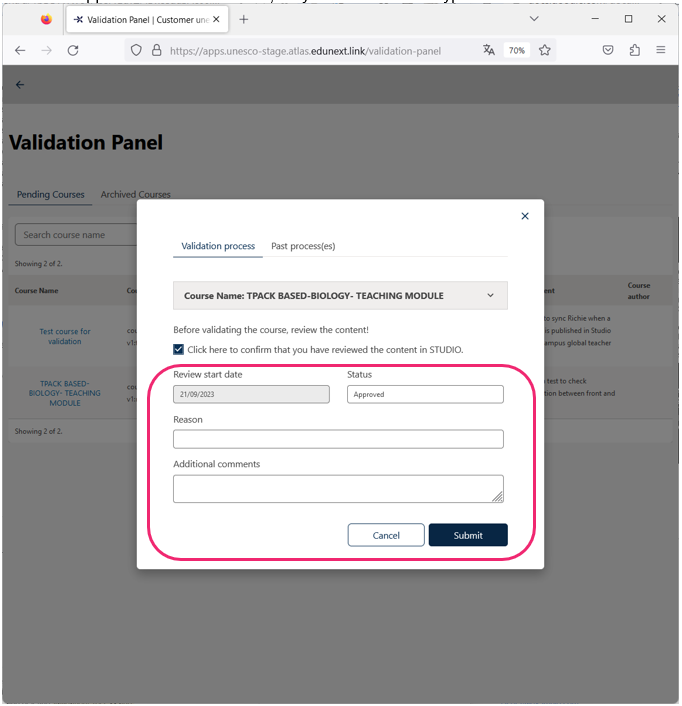2.3. Course Validator User Guide#
2.3.1. About the Validation Workflow#
To the extent the GTC project needs to democratize access to online course production, while at the same time ensuring that the applicable quality standards are met, the course validation workflow has been designed and implemented to modify the behavior of the platform as follows:
VALIDATION BODIES
There is new concept called “validation_body”, which will be managed by the super administrators through the Django admin console.
It will be possible to link a validation_body to one or more organizations from the Django admin console.
ORGANIZATIONS
An organization is the entity in the open edX platform that is offering a specific course.
Organizations can be linked to one or more validator bodies. This allows to accommodate for example scenarios where there are federal and state validation entities coexisting.
One organization can be marked as “exempt” for a particular validation body, so that the courses submitted for this validation body will be immediately approved.
An organization can be marked as “excluded” so that its courses will require no validation whatsoever. In this case, the organization should not have specific links to validation bodies, because the exclusion configuration takes precedence.
VALIDATOR USERS
It is possible to link a validation_body to one or more users by Open edX administrators from the Django admin console. These users become “validators”.
COURSE CREATORS
It is possible to grant course creation permissions to a normal user in one or more organizations. This is done by Open edX administrators from the Django admin console. We will call these users “course authors”.
A course author can also be marked as “exempt” in one organization, so that their submitted courses in that organization are immediately marked as approved.
VALIDATION PROCESS
There is a concept called a “validation_process”, that can be created for a particular course and will hold the information related to the process of submission, review and potential approval or rejection of a course.
COURSE CATEGORIES
There will be a list of categories that can be managed by Open edX administrators from the Django admin.
REJECTION REASONS
There is a list of typified reasons for rejecting a course that can be managed by Open edX administrators from the Django admin console.
2.3.2. How to Get Validator Status#
If a user needs to have the validator status, this status will be given to them by the Open edX administrator.
2.3.3. Find Courses to Be Reviewed#
Once a user has the validator status for a particular validation body, the Open edX studio home page will display a menu item that will allow them to access the validation panel.

This panel will list the relevant courses validation processes available to the specific user as follows:
For validators, the system will provide one list of pending course validation processes. This means processes, which are:
The process is in status submitted.
The process is in-review, and the assigned review is the current user.
The system will also provide one list of archived course validation processes. This means processes, that the process is in status approved or disapproved.
For both lists, the validator will be able to access the information of the process.
The validator will also have filtering capabilities to locate a course by organization, validation body, category, status, etc.

2.3.4. The Validation Review Process#
Before a validator can perform a review, they need to take a course that is submitted and SELECT it for their review. This process for Validators implies:
To select a course from the list of courses that are in status “submitted” to review it.

Once a validator has selected a “submitted” course for review, other Validators will not be able to select the same course, as it has already been assigned.
Cases, when a validator decides they will not perform the validation (for example, if they selected the course to review it by mistake), they can RELEASE the course, which implies:
Selecting return of the status of the validation process back to “submitted”.
Deleting the reference to this user as the reviewer of the course, and the previously recorded “review start date”.
Removing the course admin permissions on the course to this user.
At this point, the system will allow any other validator in the same validation body to pick up the course for review.
The review process for validators implies:
Clicking on one of the courses they have assigned in status “In review” to see all the information of the submission process.
It may not be the first time this course is reviewed, so the validator is able to visualize the info of previous processes that have been recorded for this course.

The validator can go ahead and review the course, by exploring it in detail from the Studio/LMS application with the normal functionalities. To learn how to use the STUDIO functionality to review in detail, validators are also advised to carefully read all the documentation for course creators.
The validator then comes back to the validation interface and marks the course as either: approved, disapproved or draft, giving feedback in the form of text. If they disapprove or mark it as draft, they can select some typified reason for the decision.

As soon as the status of the validation process changes to these states (approved, disapproved or draft), the validator loses the studio admin access to the course.
2.3.5. Locate Previously Reviewed Courses#
In the case that of validator user needs to check the information of previously reviewed courses this is direct accepted from the review process they can always find them in the archived courses tab.
